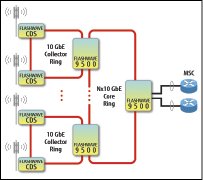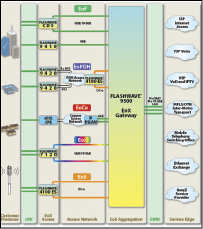Bandwidth Goes Over The Top On 4G LTE Networks
Such “over the top” (OTT) content as that provided by Netflix and Pandora Radio is gaining market traction, opening up opportunities and challenging service provider networks. Internet video is now 40 percent of consumer Internet traffic, and it will reach 62 percent by the end of 2015.*
This type of bandwidth-heavy content is wreaking havoc on service-provider networks in general. Wireless service providers, hitherto immune from much of the bandwidth demand presented by these technologies, now are working to address rising bandwidth pressure, particularly in backhaul. Whether it’s TV, Netflix streaming media, HBO-GO or the equivalent, watching video on handsets still is somewhat rare for more than a few minutes of play time, due to the typical screen size of a handset. However, with the proliferation of 4G Long Term Evolution (LTE) service, wireless carriers now are in a position to compete with traditional residential broadband service providers through a USB-modem-delivered service.
Early reports show low levels of satisfaction with LTE USB modem service, based on connection time and bandwidth throughput, but this will change as the LTE network is built out. However, once built out, the wireless service provider’s network will realize the same bandwidth bottlenecks and performance impacts as the cable and DSL based broadband services.
The initial LTE network build-out has all guaranteed services but, as competition is introduced into a metropolitan servicing area, Ethernet services will be offered at discount prices. One method of discounting service is offering classes of service based on bandwidth guarantees. The highest level of service always is guaranteed, while alternate service tiers have graduated guarantees. Service-provider access equipment with advanced traffic management provides these capabilities, employing differentiated services using guaranteed bandwidth and statistical multiplexing.
Internet radio service introduces another challenge to wireless service providers through the creation of an Internet radio station on a smartphone with little to no service charge; however, the Internet radio model on a mobile phone only is beneficial for customers with unlimited data plans. The Internet-radio scenario works like this: an employee works at a company where he is restricted from personal use of his employer’s Internet service. The employee loads the Internet-radio application on the employee’s smartphone, and the staffer listens to streaming media all day using ear buds.
With an unlimited data plan, the employee doesn’t pay extra airtime charges, and the Internet-radio app is free. This is a great benefit for the end user, but it creates significant bandwidth and latency challenges for the wireless service provider’s network – with no additional revenue. Content delivery network (CDN) service resolves most of the transit cost to wireless service provider networks at the peering point, but the network edge is a major bandwidth bottleneck.
Two methods are used to resolve these bandwidth bottlenecks. The use of additional or higher-capacity collector-ring facilities in the mobile backhaul network is one remedy. In addition to higher-capacity collector rings, a caching device at the network edge will reduce bandwidth demand through the backhaul for popular content.
 |
| FIGURE 1: MBH Network Configuration |
Currently SONET or gigabit Ethernet pipes are used in the collector ring. These collector-ring rates typically are OC-12 (622 Mbps), OC-48 (2.4 Gbps), or gigabit Ethernet (1.25 Gbps). An average LTE collector ring has between 10 and 15 cell towers using SONET, ITU G.8031 or G.8032 resiliency for sub-50 ms failover times, maintaining 99.999-percent availability. Tier 1 carriers will average 200 Mbps delivered to a cell site by 2015. Doing the math for guaranteed service yields capacity requirements of between 2 Gbps (200 Mbps x 10 cell towers) and 3 Gbps (200 Mbps x 15 cell towers) on these collector rings. Scaling using wavelength-division multiplexing (WDM) technology in the collector ring will address the bandwidth demands, but it can become expensive and complex. Upgrading to 10-gigabit Ethernet collector rings as compared to Nx OC-48 or gigabit Ethernet is a better value proposition.
In addition to addressing the bandwidth bottlenecks within wireless networks, true carrier-grade quality, performance and protection for Ethernet services is needed. Cell-tower environments are rugged, requiring outdoor carrier-grade equipment and offering only minimal footprint space. Some large cell-tower sites have special cooling systems and generators for backup power. However, in the event of a power failure, those generators won’t power the cooling systems. Therefore, temperature-hardened network elements offering operation in the range of -40° C to +65° C are used. Often, the cell-tower power plants at these sites are based on specific vendor radio equipment at +24 VDC instead of the telecommunication standard of -48 VDC, requiring flexible power options for transport equipment.
To minimize cost, cellsite equipment only has resilient network facilities for diverse paths. The cellsite equipment itself doesn’t include redundancy; service providers can afford to lose a cellsite because of overlapping service areas. At the mobile switching center (MSC), a completely different set of criteria apply. A MSC aggregation node can combine traffic from hundreds of cellsites onto a single network element. Here, resiliency is critical. All plug-in cards must be configured for redundancy.
Aggregated customer interfaces utilize link aggregation (LAG), and they split the working and standby paths over alternate plug-in cards for Ethernet services. Legacy TDM traffic from 2G and 3G networks also is aggregated here, using 1:1 or 1:n hardware-redundancy configurations for plug-in cards.
Newer hybrid Ethernet/SONET systems offer the flexibility of supporting Ethernet services as Ethernet over SONET (EoS) or as “native” Ethernet over a separate network connection. These devices provide a seamless transition from a TDM-centric network to a packet-centric network, evolving a SONET MSPP into a native Ethernet edge platform. Advanced MSPPs at the hub and MSC sites have both a TDM and a packet switch fabric to optimize traffic processing with mapping processors to translate between the two.
The mapping processor provides a smooth transition point between SONET and packet technologies, allowing the advanced MSPP to operate in a SONET network and to terminate packet traffic as well as forwarding it to higher-order networks at 10 Gbps and 40 Gbps. The higher-order network provision enables gateway operation for future packet-based network applications.
 |
| FIGURE 2: Flashwave 9500 EOX Mapper |
Over time, as the backhaul network continues to evolve toward a pure Ethernet environment, some MSPPs will offer Connection-Oriented Ethernet (COE). COE is native Ethernet and provides the highest quality, protected, broad-scale aggregation for the Ethernet traffic that dominates 4G backhaul networks. COE provides deterministic point-to-point paths for Ethernet connections, and it reserves resources for those connections through the network. This resource reservation, coupled with admission control, minimizes packet loss, latency and jitter while allowing for 50 ms dedicated protection switching.
While the evolution to Ethernet is underway, it carries with it the same expectations for performance and reliability as does a SONET implementation. Maintaining 99.999-percent availability for Ethernet service is a must, and it requires a similar level of resiliency to that found in traditional DSL hardware. There can be no single point of failure.
Mobile backhaul providers embracing the future of wireless communications should evaluate their potential technology providers fully. Implementing a modern mobile-backhaul system involves many facets, including a critical review of the existing system, a business-case analysis, schedule and strategy, solution architecture, network planning and design, solution deployment, integration and validation, network optimization and performance management.
Each generation of wireless technology has fostered increasingly sophisticated — and bandwidth-intensive — applications. 4G wireless networks will begin to challenge DSL and cable-modem wireline service, creating great opportunity for mobile backhaul providers.
Contact the author at joseph.mocerino@us.fujitsu.com.
* Cisco Visual Networking Index: Forecast and Methodology, 2010-2015; June 2011 .